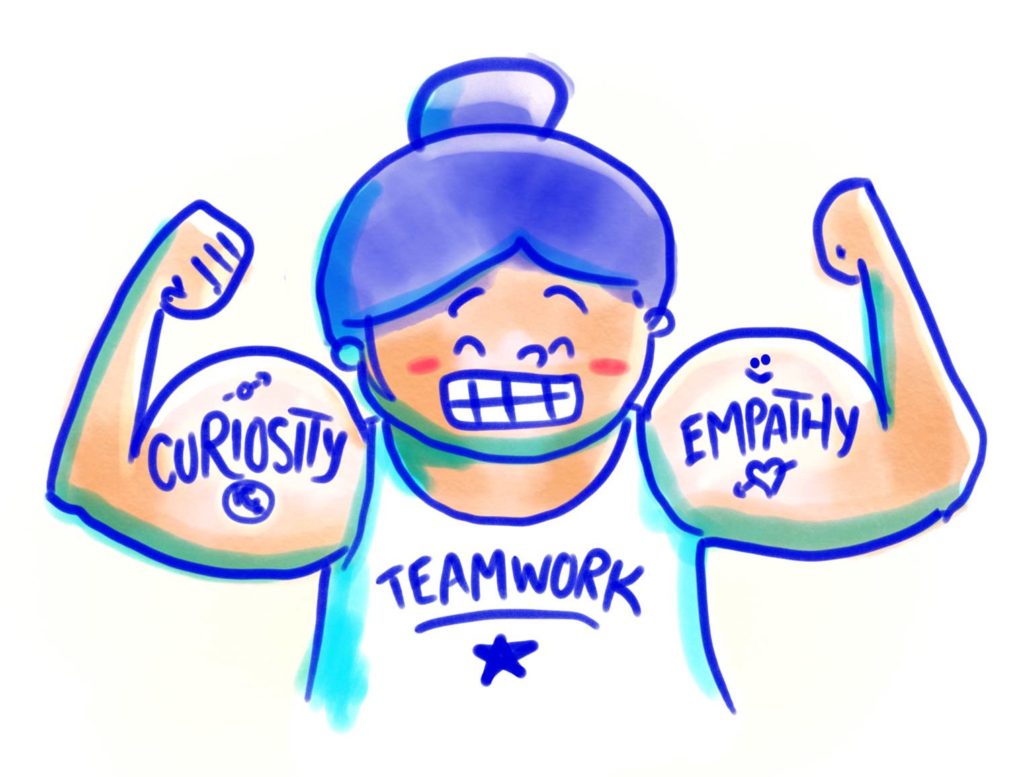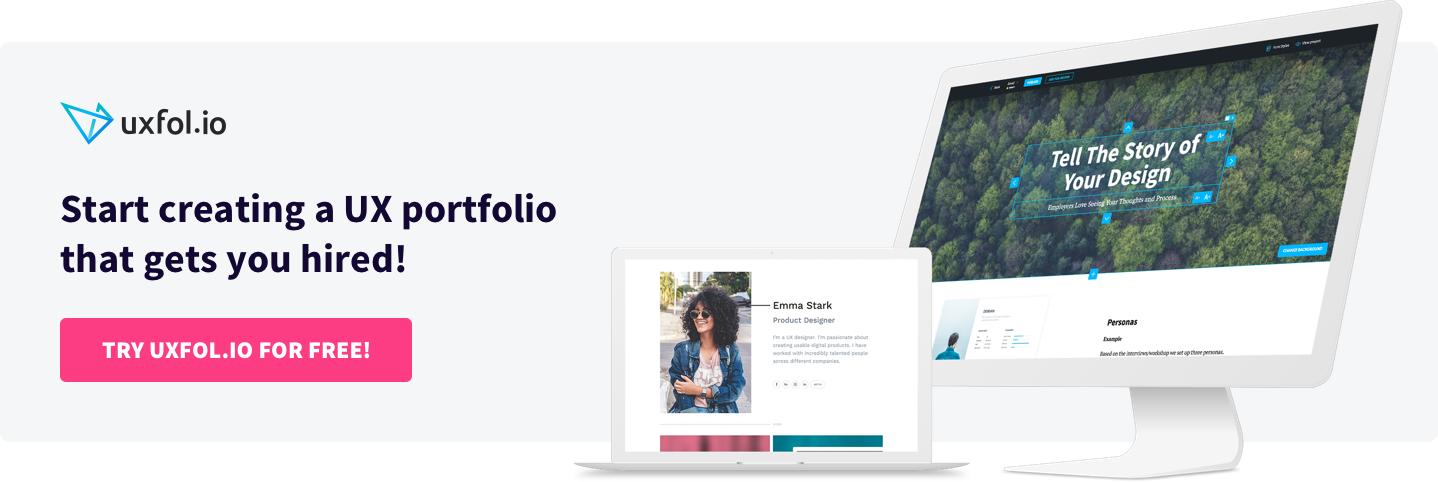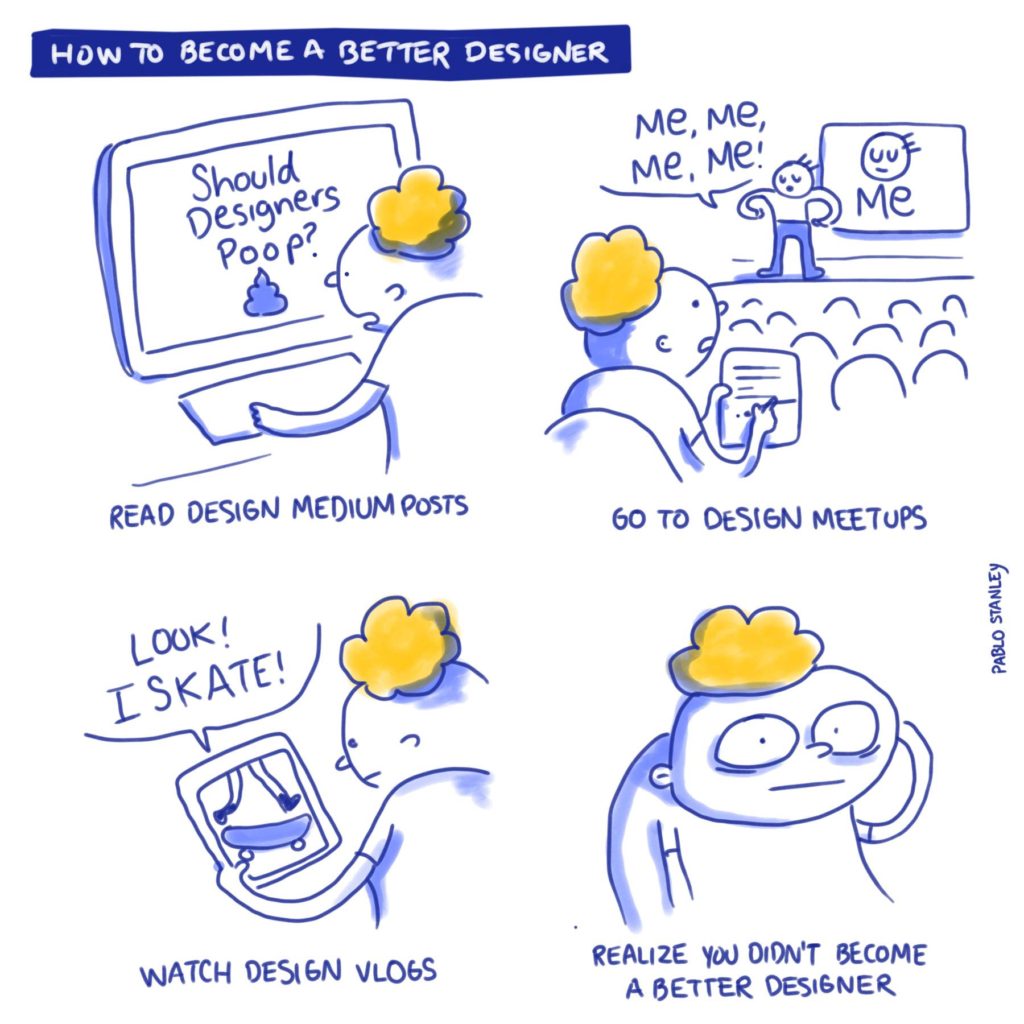After starting his career at Udemy, Pablo Stanley now not only serves as lead designer for InVision Studio Platform but he also co-founded Carbon Health. Additionally, he also works as a writer and comic artist at The Design Team and as a teacher at Sketch Together. Besides often holding design workshops and talks, he has a design podcast in Spanish and manages a design community.
I talked to Pablo at the Amuse UX Conference Budapest after attending his amazing talk on UI animation. He shared his thoughts about what skills UX designers need, how to become a better designer and what to highlight in a product design portfolio to get your dream design job.

Hi Pablo! Thank you so much for coming onto our blog. Your career path is really super inspirational for me and for our readers also. Could please tell me about how you became a UX designer?
I became a UX designer by accident! I think I was working as a comic writer for a startup in San Francisco on a three-month contract. I suppose they didn’t know I was a designer too, but my background is more in graphic design. Anyway, I was working as a comics writer for them, and I told them, “Hey, by the way, I’m also a designer.” They were like, “OK, well, let’s see your skills.” So, I started working on one of their websites, but it was really marketing stuff.
Then after that, they referred me. Again, it was luck! They referred me to a friend of theirs at another startup called Udemy, for online courses. They gave me an opportunity to work as a UX designer. The position was as a UX designer, but I didn’t know what that was. To be honest, I had to Google it and see what the hell that is.
Once I saw it, I was like, “Oh OK, it’s a lot of boxes, and a lot of triangles and text labels. That’s easy.” So, I applied. I went to an interview, and they gave me an opportunity. They knew I didn’t know anything, but they still gave one. I was very blessed and lucky to have that. I’m very thankful to Udemy for giving me that opportunity.
Well, you made a start. None of us is born a senior UX designer, that’s for sure.
You need to start somewhere, yes. And actually, I think that’s what motivated me to start creating learning content, because I had to go through that process of learning. I realized there wasn’t a lot of content out there. So, that’s also something that pushed me to start creating content for other people that probably were going through the same path as I was going, probably moving from graphic design, all the stuff and moving into UX.
What do you think, what else do UX designers need – besides luck – to work in a company like Udemy or InVision? What skills do they need?
I think a lot of it has to be with attitude and soft skills. That’s the first thing: Be a good team player, someone constantly thinking about the team and also the people using the product. You need to develop empathy, and be able to remove the ego and seriously see what the other person needs and what they want by putting yourself in their shoes.
Also listen and constantly ask questions. Try to go as deep as possible in finding a solution. So yeah, we need all of those basics, as someone able to just separate themselves from the work and seriously try to solve the problem.

On the hard skills, we – at least at InVision – do look for people able obviously to use the tools needed to do the job. Depending on the type of job, but at least for a product designer, we do appreciate a visual sensibility for visual design. Of course, some UX designer and researcher jobs probably find the visual sensibility not as necessary. But as a product designer, we do want that
In a diverse team, diverse solutions can come up.
Exactly. That’s more of a strategy on our side, but we’re not looking for one gender or for one color. We really want to have a diverse team. Every team should strive for that.
And how should designers showcase these skills in a UX portfolio? Because of course, you can put the final design work in and show your visual design skills. But what about the other UX designer skills?
I would say that in a portfolio it’s important to show their thinking process. Well, I will speak personally here. We don’t necessarily need the full process explained because we are interested in their solution and how they solved the problem. If we see it at a high level, then we’re going to ask questions anyway and we’re going to go through the process on an interview. So we want to see everything at a high level.
“In a portfolio it’s important to show their thinking process. […] Present […] the problem you were trying to solve. How did you approach it, the solution that you arrived at and the key takeaways.”
Usually, we recommend that if you want to go into detail, then reserve a space for that. But present the major takeaways from your problem, the problem you were trying to solve. How did you approach it, the solution that you arrived at and the key
So even if at a high level, is it important to showcase the design process and the design decisions in a portfolio?
Yes, I think so. But at least on my side, stuff doesn’t need to be shipped. It’s something out there. It’s more about how you approach that. If it didn’t ship, why didn’t it? Why did it fail? What things did you find out and how do you approach that
“We ask in the interview: […] “How did you involve also the people that were going to be using your product?”, “Did you do interviews? […] and “What did you learn from those things?””
But again, in the portfolio, it’s usually a high level. Usually those things, we ask them in the interview and we ask, “How do you work with the team?”, “How do you work with the developer?”, “How do you work with your PM?”, “How is the team?”, “How involved were you with the solutions with the decisions that were made?”, and “How did you involve also the people that were going to be using your product?”, “Did you do interviews? Did you do at least a poll? What happened?”, and “What did you learn from those things?”

I see. We at UXfolio also always emphasize the importance of presenting the learnings in the portfolio. How does the selection process look, more or less, in InVision?
Well, we have a team that works on hiring. So unfortunately, I don’t exactly know the process, at least on that side. But once the ball is in our court, then we do interviews sometimes with one other designer. We like to do an exercise. So while we’re doing the interview, we just ask questions and say, “Let’s open a whiteboard and actually jam on a solution of something”.
We do this because we want to see how you think through ideas and how you take feedback, how you apply it. Do you get offended when you get feedback? Do you get defensive? Also, when you talk about previous jobs, are you talking about only yourself or about the team, too? Are you talking about the user
Well, if there is not a match, we will say, “So, by looking at your portfolio, probably it’s not exactly what we’re looking for, for this position.” But usually if we see there is a fit for something else, we would actually refer them. “Hey, you know what, there’s a position for this for someone better in research, or someone more focused on development.”
But yeah, sometimes if there’s an opportunity and if the people actually gave us the time and actually made an interview, we’ll tell them, “Hey, this is what happened and these are the reasons”. Because people want to know. It’s not fair if they just get a rejection without knowing why. So we try to be conscious about that and just let people know what happened.
Usually it’s not their fault. We’re not saying, “Oh, you did something wrong”. Usually it’s just there wasn’t a match. Then you would have not liked that position anyway; you would’ve not liked working there anyway. Sometimes it’s like that.
And then they can try again for another position, can’t they?
Yeah, exactly. It’s not like, “Oh, you get only one shot!” Not at all.
My last question relates to juniors. What would you advise juniors who actually don’t have any projects yet to showcase? What should they do?
Practice. Practice a lot! There are UX challenges, there are hackathons, there are local nonprofits or charities. Try to help them.
“Practice. Practice a lot! There are challenges, there are hackathons, there are local nonprofits or charities. Try to help them.”
There are no excuses, and there are great challenges. If you want to sharpen your skills in UI, then there are UI challenges. If you want to sharpen your skills in product, then get into a hackathon.
Again, you want to present that idea in your portfolio. I know it probably wasn’t published. Probably it wasn’t really implemented. But at the end of the day, you’re going to have something where you work with a team. You worked with a developer. You worked with a nonprofit.
You were able to listen to their problems. You were able to listen to what they needed, and you acted on that. So that’s very viable. You’re going to learn something. Then, at the end of the day, you’re going to have something in your portfolio.

That’s true. We also recommend that to junior designers on our UX portfolio platform, UXfolio: Do and showcase pro bono work and imaginary websites or products to start up their UX career. Thank you very much, Pablo, for the inspiring interview and the great tips!
Take Pablo’s advice, practice as much as you can and then, present your way of thinking in your UX portfolio. In case you want to showcase your design process in your portfolio, UXfolio is a good platform for it.
We created our product, UXfolio to support UX professionals with portfolio building. It is easy and quick to build a portfolio that contains all the parts Pablo talked about. It generates you your portfolio website, a stunning front page, and it helps you put together nice project case studies in minutes
Start building your meaningful UX portfolio with UXfolio.
Click here to sign up and try it out!